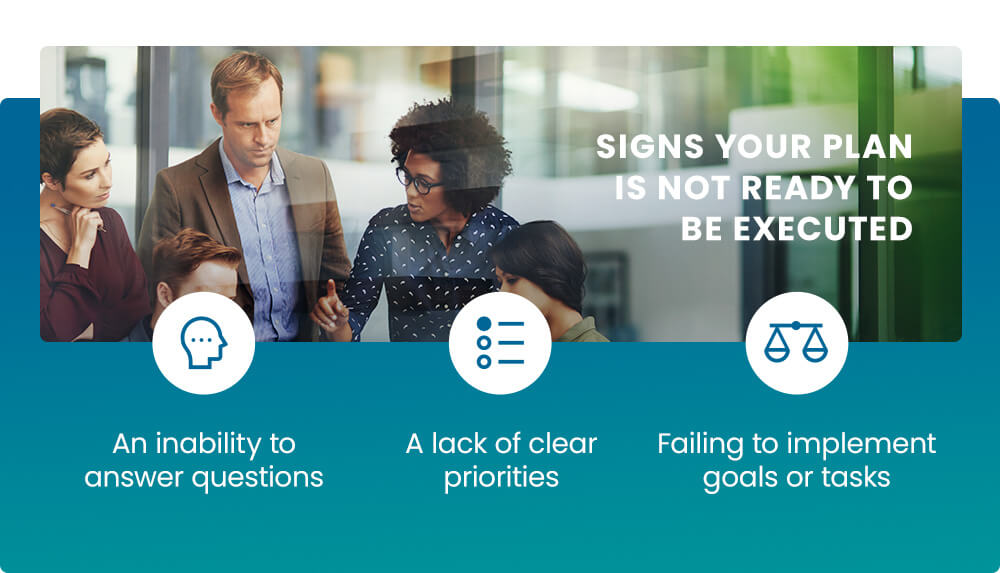Have you ever created a plan that you didn’t correctly execute? Whether it was a strategic plan, a business plan or a personal goal, it may have been difficult to understand why this meticulously-made strategy with all its potential died in the execution process.
While there are many reasons for failure to execute — how you define success, time management orthe planning fallacy, to name a few — one I’ve recently seen more and more is that the basic structure of the plan is weak.
As a leader in your organization, your plan can be built using various methodologies. Still, in the end, your idea has to address certain key elements to set your team up for a successful strategy execution plan.
In This Article
- What Causes a Plan to Fail?
- 3 Signs Your Plan Is Not Ready to Be Executed
- How to Ground Your Plan in Strong Structure
- Level One – Organize Your Plan by Theme
- Level Two – Define the Goals You Want to Accomplish
- Level Three – Quantify Objectives With Metrics
- Level Four – Define Your Strategy or Plan of Attack
- Level Five – List Your Tactical Action Items
- How to Successfully Execute a Plan
- A Plan by Any Other Name Would Smell as Sweet
- About AchieveIt: Ready to Execute Your Plan?
What Causes a Plan to Fail?
A plan may fail for several reasons. It could be due to a lack of resources or low commitment from various team members. Many organizational leaders may develop a well-thought strategy but lack the understanding of how to implement their plan. Strategies often require determination, building the plan layer by layer until the targeted issue has been addressed.
Whatever the case, you’ll want to understand how your strategic plan may fail to develop successful team practices within your organization. These 12 potential causes may help you outline an issue and work to solve it as quickly as possible.
1. Planning For Plan’s Sake
Sometimes, a team goes through the motions of planning without thinking about what they need to input to create an achievable goal. While many understand the purpose of a plan, they may not take the time to detail concrete tasks and steps or fail to identify the areas where they should prioritize work. As a result, some problems with the planning process may be addressed too late, causing a loss of funds, time or effort on the part of the organization.
2. A Lack of Fundamental Understanding
Some organizations do not understand the environment they’re involved in. Or perhaps they lack focus on results and are instead caught up in the details of the process. When paying close attention to environmental changes, setting concrete priorities and pursuing achievable results, an organization is better equipped to execute its strategy.

3. Partial Commitment
Those leaders at the top of the chain, including business owners, presidents or CEOs, should prioritize the execution of their strategies and stay committed to improving their plans. However, even the best marketing plans may fail when strategies are not correctly implemented or team members are not committed to their tasks. Those not up to the challenge of solving current issues may miss the mark
4. The Wrong People Involved
From those executing your plan to those creating the plan in the first palace, those members must be involved from the beginning and see the plan through to fruition. If organizations fail to hire skilled workers, recruit knowledgeable employees or cannot find anyone to complete specialized projects, they may fail to execute the plan.
5. Shelving Plans
Even if you’ve written the strategic plan out already, shelving it can hurt the project in the long run. You want to ensure your team uses and reviews the plan rather than letting it sit on a shelf or in a drawer collecting dust.
6. No Change
When unable to change the company’s strategy or adapt to changes in the environment, it may be due to a lack of proper planning or a backup plan. Teams must be able to adjust to the current situation, and conduct thorough research and plans should their strategy fall through.
7. The Wrong People in Leadership
Those in management or leadership positions should be able to make tough decisions that others won’t. The right leaders advocate for the strategic plan successfully and ensure that it stays on track no matter what.
8. Ignoring Facts
Your organization must look closely at marketplace facts and realities. Make sure you take potential risks seriously and plan for issues in advance. Even if project data is scarce, you’ll want to be sure you’re researching closely in the initial planning stages. Using the proper tools may help you locate the correct facts and modify your plans accordingly. Every project evolves as new information becomes available, and the right organization will be aware of this and work to rewrite its plans based on further information.
9. A Lack of Accountability
When teams lack accountability, it can hurt the process, especially after the plan has already been developed and funds have been acquired. There may be consequences when the organization cannot follow through on its original plan.
10. Unrealistic Goals
The strategic planning process should focus on as many goals, programs or objectives as possible. Fewer objectives mean more focused research and tasks, allowing members to achieve realistic goals that are concrete and measurable.
11. Frequent Changes
Too many changes to the plan may confuse others or create a plan that strays too far from the original. Sometimes, it could lead to internal issues or constraints on funds and resources.
12. Undefined Roles
In other cases, the roles within the organization may not be clear. Project managers or team members often drive immediate results and tasks, but you may not have communicated expectations for their performance measurements. Everyone on the team should clearly understand their exact role and how they contribute to the strategy. Ensure they know who to report to and where feedback will come from throughout the process.
3 Signs Your Plan Is Not Ready to Be Executed

If your plan is not yet ready to be executed, a few signs may tell you it’s time to give the strategy another look. Look at these three areas to decide where your plan can improve.
1. An Inability to Answer Questions
If you cannot answer important questions about your strategy, you may not be ready to execute your plan. Some questions include the following:
- Who: Who are your customers and competitors?
- How: How will you serve those affected? How do you plan to beat your competitors? How will you plan for potential issues or scenarios?
- What: What are your plans for building and maintaining your strategy? What potential scenarios can predict your future? What threats or opportunities exist for your organization?
2. A Lack of Clear Priorities
Your company should be able to identify clear priorities and the value in each of your strategy’s areas. If you can’t outline key priorities or settle for vagueness, you are unlikely to get anything done.
3. Failing to Implement Goals or Tasks
Perhaps your team has clear priorities outlined but often fails to execute strategies or complete tasks. You may see some problem areas, such as:
- Neglect: Lack of resources or funds for the strategy, such as training, technology or staff.
- Unclear roles: Failing to help busy staff members or set clear roles and responsibilities.
- Lack of commitment: Giving up after experiencing issues.
How to Ground Your Plan in Strong Structure
Developing a plan should involve system design and conscious thought into how it cascades appropriately throughout the organization.
This is the only goal leaders building a business plan should aim for.
The words and language you use don’t really matter.
When I uncover this exact plan formulation problem with customers, I’m often asked for recommendations on a proper structure to enhance business plan execution. With so many prescribed methodologies and techniques available, what’s the best way to plan?
This may sound blasphemous to some in the strategy world, but I don’t care if you call something a goal or objective, strategy or initiative. As long as your organization knows what each term means, your plan will gain strength from the structure, not the words.
So, what do I recommend, then? I’ve outlined a basic 5-level structure below that will enable success.
Note that while there are levels to this plan, all five levels may not apply to every organization. You may find your company doesn’t need the broad-sweeping focus of level one, while others may not need the detail in level five. It’s about finding balance and the proper approach for your organization.
Level One – Organize Your Plan by Theme
A theme is the most organizational level of your plan. Themes are used to divide the rest of the plan into organizational categories of the business.
For example, you might choose to segment your plan based on departments, areas of focus or geolocations. The theme you choose will give you those breakdowns.
Some smaller plans or organizations may not need this additional level.
Level Two – Define the Goals You Want to Accomplish
Goals define what your business is striving to complete. Statements at this level are generally a sentence or two outlining where you want to be in the future.

Think of it as a miniature vision statement. An example of a good goal would be “To become the top service provider in the Southeast” or “To be top five in patient satisfaction.”
Every type of plan – even plans for personal goals – must have these definitions of success.
Level Three – Quantify Objectives With Metrics
Objectives are the quantitative outcomes that will help you reach your goals. Assign the KPIs, metrics or measurements to your goals that will signal when you’ve “become the top service provider in the southeast.”
As discussed previously, quantitative metrics are crucial to measuring your objectives’ success and plan. An objective shouldn’t be to implement, develop or deploy something – it should be to increase, decrease or maintain a specific figure.
Again, most plans will need this detail to know when you’ve reached your goals.
Level Four – Define Your Strategy or Plan of Attack
The strategies in your plan will be the adjustments you make to accomplish your objectives. These could be traditional business strategies, or in some organizations, they could be the initiatives and projects meant to steer the organization in the right direction.
Level Five – List Your Tactical Action Items
The last level of the plan is your tactics. As expected, these are the smaller items that make up your strategies. They are the bite-sized pieces that allow you to realize your strategy. These could be referred to as milestones, deliverables or something else altogether – again, it’s not the vernacular that’s important. Whatever you call them – these are the action items your team can take to make your strategy happen.
How to Successfully Execute a Plan

After successfully grounding your plan, it’s time to execute your strategy. You’ll want to follow a few guidelines to succeed in your implementation.
Step One — Plan
You’ll want to plan for your execution before it’s even started. Ensure your strategy is good by reviewing your documentation and ensuring your plan answers crucial questions, such as why, who, what, when and how.
Address how you plan to achieve your goal and your steps so far. Detail your plan’s framework and reporting structure and how frequently you’ve conducted meetings and communicated with team members.
Step Two — Execute
Execute your plan and ensure communication across every section of your team. Continue making status updates to check for possible issues, and respond quickly to current risks or problems that arise during the process. A well-designed project management plan may help you organize these areas better.
Step Three — Monitor
Again, communication should be your priority. You’ll want to be sure that the project is proceeding without interruptions. Monitor specific areas such as costs, scope, resources and funds scheduling to prevent or respond to possible problems.
Step Four — Control
If you do run into an issue, take corrective action to get your team back on track and keep the strategic plan running. As you improve your process, communication and status reporting will be more critical than ever. Corrective action may look like:
- Identifying issues or risks
- Extending schedules
- Reallocating team members
- Decreasing or increasing the budget
- Cutting down the scope

A Plan by Any Other Name Would Smell as Sweet
Remember, a strategic plan at its core will help your organization achieve its goals.
If you start to get hung up on “correctly” defining your future state during the plan creation process, remember that your plan is only a series of bets placed around the organization. From the bottom level up, you’re hoping the bets you cash in increase exponentially as you cascade up the plan. By accomplishing your tactics, you complete your strategies, move the needle in the right way on your objectives and position yourself to achieve your goal.
Since you are placing bets, giving yourself and your organization the best chance of winning makes sense. That’s why organizations create plans structured for execution and use AchieveIt to track and monitor appropriately.
About AchieveIt: Ready to Execute Your Plan?
Large organizations across various industries use AchieveIt to take their most important initiatives off the shelf and into reality. Some incredible ideas never come to fruition because of a lack of organized strategy courses, tracking or reporting. What do you need to successfully execute your plan?
- Organize your view: Understand the details of every initiative’s levels, from the enterprise to the individual in a real-time platform.
- Engage your team: An easy-to-use platform connects your organization. From executive leadership to the project teams, our program keeps everyone engaged and on track.
- Find your advantages: Use our premier platform, and draw on the experience and practices of our Execution Experts.
Whether you work for a corporation, health care system or federal government agency, AchieveIT can help organize your team with our Integrated Plan Management. Contact AchieveIt online to schedule a demo, or call us at 1-800-535-1559 and speak to a representative today.



